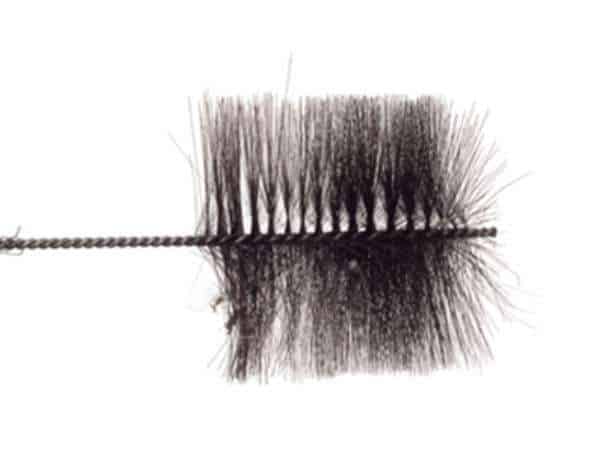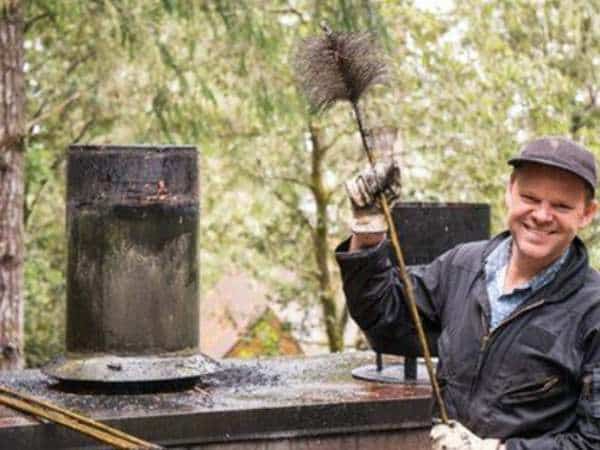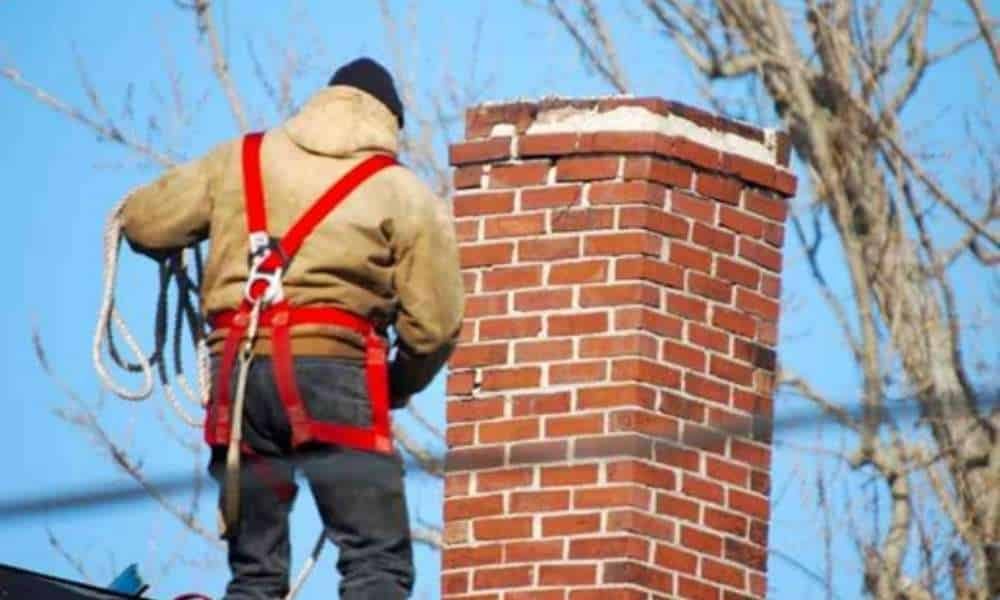Nothing rings in the holiday season like sitting around a roaring fireplace. And if you haven’t already, now is the perfect time to clean your chimney. Because you use your fireplace to burn wood for warmth or just for seasonal ambiance. A highly flammable substance known as creosote begins to build up on the interior of your chimney walls. Maintaining a clean chimney is essential to keeping your home safe for the winter. This buildup can ignite and burn at temperatures of more than 2,000 degrees Fahrenheit over time. Which can be very challenging to put out and swiftly spread to other parts of your home. How to Clean Your Chimney – DIY.
In fact, on average there are over 25,000 of these chimney fires. Every year that leads to over $125 million in property damage. I rate these projects by how many F-bombs you’re likely to drop while tackling the project. This one isn’t too difficult, but it takes a little bit of time and can get a little messy. Requires you to get on your roof, and requires some basic tools to knock it out.
Fortunately, cleaning your chimney isn’t a super challenging task. And it’s something that most homeowners can tackle on their own if they choose to. So today you are going to learn how you can do it. And why you should add this to your to-do checklist to make sure. That your home is ready for the winter. Before we get started, I’m first gonna describe to you how a fireplace works because I find that. You know how things are with your homework. It’s easier for you to fix them when they break or when they need maintenance.
How does a Fireplace Work?
So the major components of a traditional fireplace are the firebox. A damper the smoke shelf and smoke chamber, the chimney flue or liner, and the crown. As a fire burns, the heat and smoke rise through the damper to the smoke chamber. And up the flue. On the smoke shelf, turbulent air mixed from within. The room and the air in the chimney should form an updraft. Sending the smoke back up the chimney and away from the living area. Now, the damper can be used to close off. The chimney when not in use so cold air doesn’t fall through. The chimney creates drafts in the living space.
Preparations & Process of Cleaning the Chimney
Purchase a Chimney Cleaning Brush

You should only clean your chimney after a long period of time without lighting a fire in the fireplace. You’ll need to start by ordering a straightforward chimney cleaning brush online or from a hardware store. Now, there are a ton of different options available in various sizes, so you may want to go on your roof and measure the diameter of your chimney flue or the liner to make sure that you buy one that fits.
Tape off the Fireplace Area
Next, you’ll want to use some plastic and tape to tape off the fireplace area or make sure that your wood stove is closed and sealed. This process creates a lot of soot flying around, and you don’t want all that flying around into your home. I also like to add a shop vac hose into the sealed firebox area to help collect any flying dust. How to Clean Your Chimney – DIY.
Get to the Top of Chimney
From there, you’ll need to get up to your roof, so make sure that you can do that safely with a ladder. It becomes a little more challenging for steeper-pitched roofs, so make sure that you take the necessary safety precautions so that you can access the roof and the chimney safely. Depending on how high your chimney sticks out of your roof, you may need an additional step ladder or stool to get to the top so that you can access the very top of the chimney. How to Clean Your Chimney – DIY.
Removing the Chimney Cap

The chimney cap should be removed. Typically they’re installed with just a few screws to hold them in place. Not only do they prevent birds and other animals from nesting or climbing down the flue and getting stuck, but they also keep other debris out like leaves and branches or things that can cause a clog that could potentially be problematic down the line.
To my knowledge, they’re also required during a home inspection, so if you ever plan to sell your home you’ll need to have one installed. They’re not very expensive online and most cover different size ranges, so just measure your chimney liner to buy one in the size range that fits.
Inspect the Chimney from the Top
Next, you’ll want to use a flashlight to shine down the chimney and see what you’re dealing with. Now, if you have a Go Pro or an action camera of some sort, this is a perfect use for that as you can attach it to a long pole and send that down the chimney to see any visible obstructions and inspect the condition of the chimney to make sure there’s no visible obstructions or damage. How to Clean Your Chimney – DIY.
From there, assemble your cleaning brush. It’s a matter of attaching the fiberglass rods together and putting the brush attachment on the end. And if you have someone down in the house below, ask them to turn on the shop vac for you. Otherwise, you have to climb down and turn on the shop vac. Make sure you have a good respirator, safety glasses, and gloves on hand so that you protect yourself from any flying debris and potentially carcinogenic dust.
Brush out the dust from the Chimney
If you have a brush that attaches to a drill and once you’ve fed the rods down the chimney and you’ve reached the length of your chimney liner, make sure the chuck is tightly linked before attaching the other end to the drill.. You don’t want to drop the rods down the chimney because then you have to try and fish it out, which can be challenging.

Start at the bottom of the chimney and work your way up, but it doesn’t really matter how you do it. Just work your way through the entire liner and make sure that you clean it thoroughly. Once you think you have it nice and clean, use your flashlight or camera to make sure it all looks good, and try your best to clean any additional spots that you notice that maybe didn’t get cleaned so well. How to Clean Your Chimney – DIY.
Once the chimney’s all clean, replace your chimney cap and you’re good to go on the roof. From there, allow the dust to settle for at least 30 minutes so that anything. That’s flying around can settle into the firebox. And then next, locate your chimney cleanout if you have one. It’s usually a door on the backside of your fireplace or your chimney. And you can use a small shovel or scoop to remove all the larger debris that may have fallen.
If you don’t have a cleanout, just do your best to clean any remaining dust out of the chimney with your shop vac. They sell specialty vacuums for this. However, if you’ve already removed the majority of the ash from your fireplace, I don’t really find them necessary as long as you have a good filter in your shop vac.
Finishing the Process
Do your best to clean any remaining dust out of the chimney and firebox with your shop vac. And lastly, reinstall any fireplace screen or doors if you have them, and you’re good to go to enjoy many warm fires in your fireplace or wood stove for the winter season. It doesn’t harm to sometimes burn one of these creosote-busting logs in your fireplace. They’re designed to help keep creosote from building up, but they should never be used as a replacement for a good chimney cleaning.

If you have a gas line that runs to a gas starter on your fireplace and doesn’t want to deal with the hassle of a wood fire every year or doing the deep cleaning, you can also replace your wood-burning fireplace with either a gas insert or a gas fire log set. These log sets are a little expensive, but they use either natural gas or propane to create a clean-burning fire without the hassle of creating a lot of ash and soot. How to Clean Your Chimney – DIY.
As always, you want to make sure that you have quality smoke and carbon monoxide detectors inside your home and that they’re working properly.
Chimney cleaning is a do-it-yourself project but it can become hectic, sometimes, when we run the brush down the chimney and it pulls out all the dust, debris, and lint. Moreover, getting to the top of the roof and doing all the cleaning yourself can be dangerous too. So, it’s better to call a professional cleaning company that has experience cleaning every type of chimney installed nowadays.




